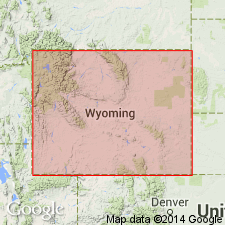
- Usage in publication:
-
- Satanka shale*
- Modifications:
-
- Named
- Dominant lithology:
-
- Shale
- AAPG geologic province:
-
- Green River basin
Summary:
Named for the Satanka railroad station, Albany Co, WY in the Greater Green River basin. No type locality designated. Consists of about 200 to 232 ft of red shale that overlies the newly named Casper formation and underlies the newly named Forelle limestone. Section measured 8 mi south of Laramie where the Satanka is 232 ft thick. [Age not clearly stated, but is Permian age by inference.]
Source: GNU records (USGS DDS-6; Denver GNULEX).

- Usage in publication:
-
- Satanka Shale*
- Modifications:
-
- Areal extent
- AAPG geologic province:
-
- North Park basin
- Green River basin
Summary:
Satanka Shale (of Leonardian and Wordian age) used in south-central Wyoming and North Park, CO. Name Owl Canyon Formation (adopted by the USGS) replaces use of Satanka in northeast CO. Satanka overlies Casper Formation and underlies Forelle Limestone Member of Goose Egg Formation. Upper part of Satanka is equivalent to Glendo Shale Member of Goose Egg Formation.
Source: GNU records (USGS DDS-6; Denver GNULEX).
For more information, please contact Nancy Stamm, Geologic Names Committee Secretary.
Asterisk (*) indicates published by U.S. Geological Survey authors.
"No current usage" (†) implies that a name has been abandoned or has fallen into disuse. Former usage and, if known, replacement name given in parentheses ( ).
Slash (/) indicates name conflicts with nomenclatural guidelines (CSN, 1933; ACSN, 1961, 1970; NACSN, 1983, 2005, 2021). May be explained within brackets ([ ]).

